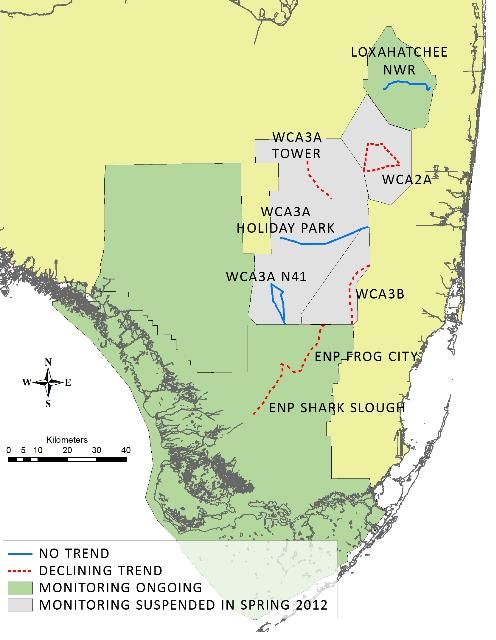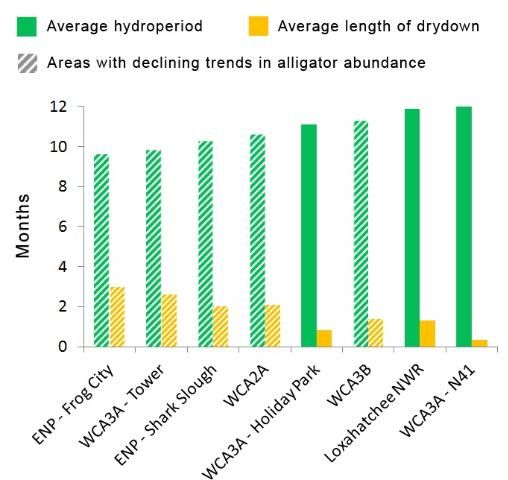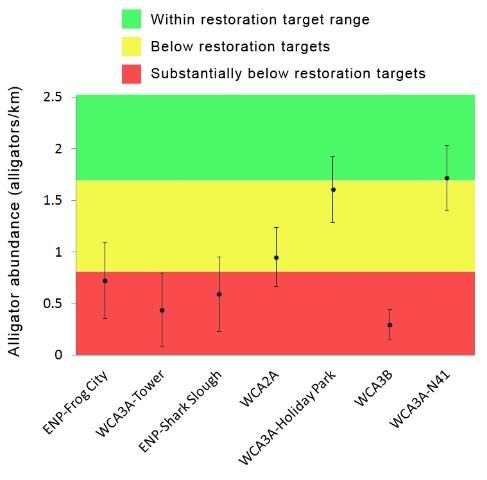The American alligator (Alligator mississippiensis) is a powerful indicator for Everglades restoration. It responds clearly to environmental change and is easy and inexpensive to monitor. As top predators and ecological "engineers," alligators affect nearly all aquatic life in the ecosystem. Thus, trends in alligator populations can tell us whether restoration projects are successful. Alligators may be monitored for both short-term responses (body condition) and longer-term responses to ecosystem change (abundance). Here we discuss trends in alligator abundance.
Long-term monitoring allows us to compare trends in alligator abundance in different areas of the Everglades and relate them to hydrological patterns.
Since 2003, researchers have monitored alligators twice in spring and twice in fall along eight survey routes in Everglades marsh ecosystems. Monitoring was suspended in 2012 on five routes on state lands. Today, monitoring continues on Department of Interior lands and in Water Conservation Areas.
We found that alligator abundance (measured as relative density) significantly declined in five areas and did not change in three areas (Figure 1). The declines occurred in areas with drier conditions (Figure 2).

Credit: RECOVER (2014)
Alligator abundance has declined in drier areas but has not changed in wetter areas.
These data suggest that alligator abundance remains stable in areas with these characteristics:
- hydroperiods longer than 11 months per year
- drydowns no longer than about 40 days (1¼ months)
- at least two years between drydowns (see Table 1)

Credit: RECOVER (2014)
Frequency of drydowns in eight survey areas in Greater Everglades ridge and slough. Source: RECOVER (2014)
Continual, system-wide monitoring of alligators can tell us how the ecosystem will respond to restoration.
If we get the water right, alligators will do better and so will the Everglades.
Alligator populations are below restoration target levels (Figure 3) and declining in drier areas such as WCA3A, WCA3B, and ENP-Frog City. Restoration projects like Tamiami Trail Modifications and the Central Everglades Planning Project (CEPP) (see http://www.evergladesplan.org/pm/projects/landing_projects.aspx; accessed August 2014) will restore more natural water levels and increase freshwater flow into these areas. Improved water and salinity patterns will support healthier alligator populations, which will improve the diversity and function of the whole ecosystem.

Credit: RECOVER (2014)
Monitoring data from 2003–2013 allowed us to refine what we know about alligators and describe the relationship between alligators and hydrology more specifically:
"Restoration of sheet flow and related water depth patterns consistent with the understanding of pre-drainage condition, in combination with the removal of canals, will result in a widespread increase in alligator density and body condition in the Everglades." (RECOVER 2004)
"Longer hydroperiods and less frequent drydowns will result in an increase in relative density of alligators. Maximum relative densities will be achieved if drydowns are on average once every 3–5 years." (USACE 2013)
Long-term data on alligators can be used to improve management decisions.
Long-term monitoring enables us to do the following:
Develop operational plans that address specific hydrological targets.
- Aim for hydroperiods longer than 11 months and drydowns that occur no more often than every 3–5 years to support healthier marsh alligator populations.
- Avoid consecutive years of drydowns that last longer than 40 days to maintain alligator population density.
Distinguish between effects of natural events (droughts, hurricanes) and effects of management activities.
Increase flexibility of operations and management decisions.
Develop and refine ecological tools that aid in project planning.
- For example, the alligator habitat suitability index is used in CEPP planning.
Understand complex ecosystem dynamics.
- For example, alligators alter ridge and slough microtopography and affect populations of fish and wading birds.
Detect small and gradual changes in alligator responses to environmental conditions, which could be masked by natural variation over shorter timeframes.
Quantify the value of restoration investments.
- The health of alligator populations can indicate where and when restoration actions are meeting restoration targets. Likewise, alligator populations that are below target levels indicate where more restoration actions may be needed.
Conclusion
These monitoring data show that alligator abundance is below restoration targets and declining through much of the central and southern Everglades, highlighting the need for more restoration in the central part of the system. These data have been used to help develop the next phase of restoration projects, the Central Everglades Planning Project (CEPP) (USACE 2013) and have contributed to development of the CEPP adaptive management and monitoring plan. In addition, this monitoring will allow us to assess responses of alligators to a more natural flow of water that will result from the Tamiami Trail Modifications project. We expect to see increases in alligator abundance as more natural hydropatterns are restored.
References
Brandt, L.A., J. Boyer, J. Browder, M. Cherkiss, R.F. Doren, P. Frederick, E. Gaiser, D. Gawlik, S. Geiger, K.Hart, B. Jeffery, C. Kelble, J. Layne, J. Lorenz, C. Madden, F. J. Mazzotti, P. Ortner, M. Parker, M. Roblee, L. Rodgers, A. Rodusky, D. Rud-nick, B. Sharfstein, J. Trexler, A. Volety, 2012. System-wide Ecological Indicators for Everglades Restoration. 2012 Report. Unpublished Technical Report. 90 pp.
REstoration COordination and VERification (RECOVER). 2004. Monitoring and Assessment Plan for the Comprehensive Everglades Restoration Plan. January 2004. http://www.evergladesplan.org/pm/recover/recover_map_2004.aspx
REstoration COordination and VERification (RECOVER). 2014. Draft 2014 System Status Report for the Comprehensive Everglades Restoration Plan. March 2014. http://www.evergladesplan.org/pm/ssr_2014/ssr_main.aspx
U.S. Army Corps of Engineers (USACE). 2013. Central Everglades Planning Project (CEPP) Draft Integrated Project Implementation Report and Environmental Impact Statement. Annex D, Adaptive Management and Monitoring Plans. August 2013. http://www.evergladesplan.org/pm/projects/docs_51_cepp_draft_pir.aspx
For more information contact:
Frank J. Mazzotti
UF/IFAS Fort Lauderdale Research & Education Center
3205 College Ave., Davie, FL 33314
Email: fjma@ufl.edu